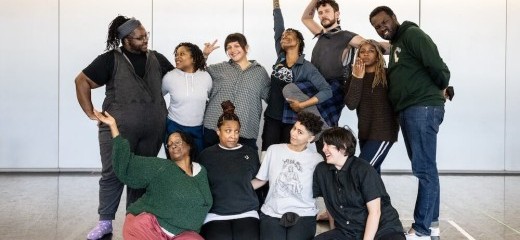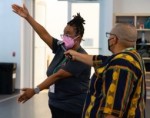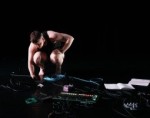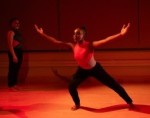
Kayla Hamilton ‘Dreams Larger’ with a Disability Futures Fellowship
by Rachel DeForrest Repinz
This year’s just-announced Disability Futures Fellowship (DFF) was awarded to Kayla Hamilton as its sole dance artist among 20 Disabled awardees working within a variety of artistic disciplines. In her own words, Hamilton’s work “reimagines a dance world where Black Disabled and other multiply marginalized creatives are central.”
A Ford and Andrew W. Mellon Foundations initiative, the award provides $50,000 in unrestricted funding per artist. Past award cycles have included fellow visionary dance artists Alice Sheppard, Jerron Herman, and Antoine Hunter, a/k/a Purple Fire Crow.
Hamilton’s work embodies the Fellowship’s mission of supporting Disabled artists who “push their fields forward as well as cultivate new opportunities and audiences for other Disabled practitioners.” An established choreographer, Hamilton’s works have been presented at venues including Gibney, Performance Space New York, and New York Live Arts. In addition to her performance work, Hamilton co-developed Crip Movement Lab with collaborator Elisabeth Motley, a pedagogical framework that centers cross-disability movement practices for every body. I recently asked Hamilton to reflect on the impact of the Disability Futures Fellowship, the recent launch of her new cultural organization Circle O, and her premiere of How to Bend Down/How to Pick it Up at The Shed in New York next month.
As a DFF recipient, Hamilton looks forward to expanding connections by “collaborating with people, meeting new people, connecting people.” “I’ll be touring the Crip Movement Lab, which is really a way of being with other people, and hopefully How To Bend Down/How to Pick it Up will also be able to tour so we can be with people that way as well.”
Hamilton also spoke to the tangible impacts of unrestricted awards like the DFF and how they support artists both in creating new work and in taking time to care for themselves. “Unrestricted grants and awards are a gift for any artist. The trap of productivity and hustle is real, and when funders trust artists to use funds in the way that will best support their life, work, and creative vision – it is rare and invaluable. These awards provide the time, space, and capacity for moving slow, for care-filled collaboration, and for collective creativity. And to just support life. I think this is especially valuable for Disabled artists.” She adds that it gives her “the means and the audacity to dream larger and to dream outside of myself. It is important that we name that: what resources can do for dreams.”
Just a few days before the fellowship announcement, Hamilton launched Circle O, a new cultural organization that “reimagines a dance world where Black Disabled and other multiply marginalized creatives are central and every body is worthy of care,” according to its website.
“Circle O is really about putting a container or umbrella around the things I’ve already been doing (performing, educating, consulting); now… all these things can speak to and be with each other… All facets of the work are creative endeavors, not just the performance making. The teaching, for example, is also performance, is also creative, is also choreography. All of the Circle O wings are artistic endeavors.”
Looking ahead, Hamilton’s latest work, How to Bend Down/How to Pick it Up, will premiere at The Shed in August. This project, rooted in collaboration and interdisciplinary inquiry, is her most ambitious project yet. She related that “this work truly belongs to our entire cast and collaborator community. The artists of HBD/HPU are a group of twelve incredible Black, Deaf, and Disabled performers, four video artists, and other collaborators; together, we have created a cross-disability space to discover and find new ways of doing/being where Black Disabled imagination and creativities are at the center.”
As Kayla Hamilton embarks on this transformative new chapter in her career, the Disability Futures Fellowship not only recognizes her remarkable contributions to the dance field thus far but also empowers her to sustain and expand her visionary work into the future. Tune in at The Shed next month.
Kayla Hamilton, How to Bend Down/How to Pick it Up, in The Shed’s Open Call series, Aug. 15-17, free with ticket reservation.
Image #1: A black & white image of Kayla Hamilton, a dark-skinned Black woman. She is dancing in front of a textured wall that has horizontal layers. Her arms are energetically reaching down to the diagonal as her head is tilting to the diagonal with her dreads moving back in that same direction. She wears a diagonally striped long sleeve shirt with pants. Photo by Travis Magee.
Image #2: The cast of How to Bend Down/ How to Pick it Up poses for a group photo. Some performers stand and some sit or kneel on the studio floor. It is a joyful moment: everyone is smiling, gesturing, or making a fun face. Photo by Maria Baranova.
By Rachel DeForrest Repinz
July 24, 2024







